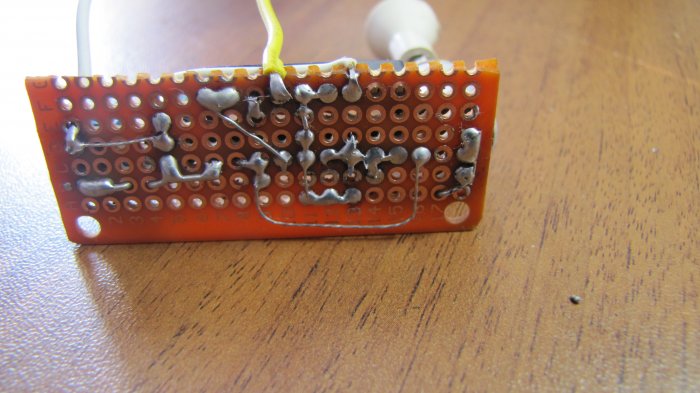DIY DIY DIY
Traffic regulations require that during the day the car drives with daytime running lights (DRL - Daytime running lights). Their function can be performed by:
- dipped beam headlights;
- fog lights;
- High-beam headlamps powered by low-voltage on-board network;
- separately mounted lights.
DRLs are required to improve daytime visibility and improve road safety. The main DRLs differ from parking lights is that they should provide visibility of the car during the day, so their brightness should be high enough.
What should be the headlights
The following requirements (GOST R 41.48-2004 and GOST R 41.87-99) are set for the headlamps, which work as sidelights:
- they must be mounted on the front of the vehicle;
- DRLs must contain two light-emitting elements installed at a height of not less than 250 mm, not more than 1500 mm and not closer than 600 mm from each other
- the distance from the edge of the car must not exceed 400 mm;
- the color of the light - only white;
- the light intensity must be not less than 400 and not more than 800 candelas;
- the area of light emission - not less than 40 square centimeters;
- Horizontal angle of the light should be 20 degrees, vertical - 10 degrees.
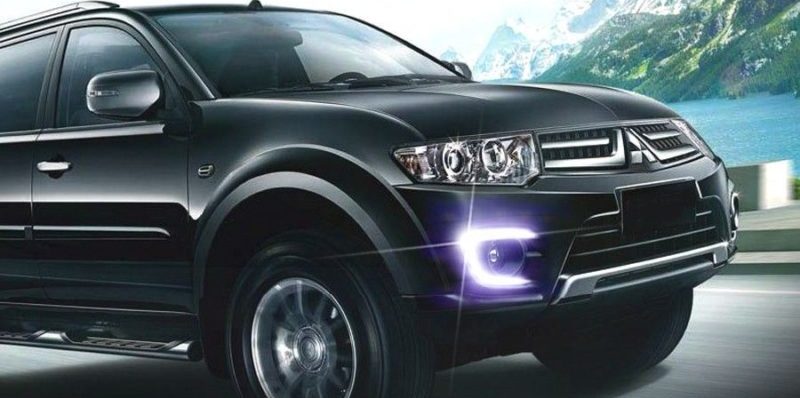
DRLs must be activated when the ignition is turned on. If the car is not equipped with DRLs, you can make and install the running lights yourself. Homemade lights must meet all the specified requirements.
If light elements are installed on the car, not provided by the regular design of the car, the changes must be registered in the traffic police.
Read also: Description and deciphering of daytime running lights
What you need to make
The best option - to make daytime running lights on LEDs. This option will reduce the load on the on-board network of the car, reduce the heating of the generator, save the battery charge when starting the engine. The lights on the LED strips look spectacular. But there are problems with LED strips:
- The length of the standard strip is a multiple of 1 meter, it is difficult to fit such a light in the dimensions of the front panel of the car with compliance with all the rules;
- The scattering angle of most LEDs is 120 degrees, which does not fit into the established standards, and focusing system for a long web is problematic.
Therefore, it is recommended to make LEDs on separate LEDsinstalled in the cases with reflectors, which focus the luminous flux within the required limits.
Proper selection of components
The biggest problem - to ensure a minimum level of light intensity of 400 cd. Thus, a common LED of size 5730 has an angle of half radiation of 120 degrees. With a luminous flux of 50 lm the light intensity will be only 16 cd. Calculations show that when you install focusing system (lens and (or) reflector), concentrating the light flux within an angle of 20 degrees, the light intensity will increase by about 2 times (taking into account the use of light flux and losses), but in this case is not decisive.
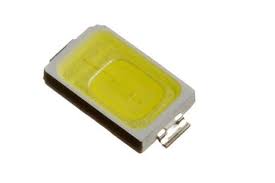
We need pay attention to LEDs of 1W, or better 3W (taking into account the practice of overstating the claimed characteristics of manufacturers). So, a three-watt white LED from Epistar gives a luminous flux of 300 lm and light intensity of 95 candelas. Taking into account the action of the focusing system from four such LEDs you can get the minimum required 400 cd. Another condition - the area of radiation is not less than 40 sq.cm. With a 20mm diameter LED lens its area will be about 3 sq.cm and to get the required area you will need at least 10 of these LEDs. Probably the total light intensity will not exceed 800 cd, to get the real result you need to make laboratory measurements.
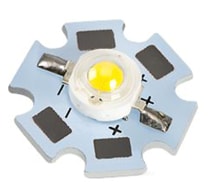
Such light-emitting elements can not be installed without a heat sink - they are not designed for such a mode. The final list of materials will be as follows:
- The required number and type of LEDs (determined by calculation and selection);
- heat sink plate;
- focusing system;
- housing;
- connecting wires.
Then you can proceed to the assembly of the LEDs.
| LED | Power, W | Angle, deg | Color | Luminous flux, lm | Lens diameter, mm (emitting area, sq.cm) |
|---|---|---|---|---|---|
| ARPL-Star-1W-BCB | 1 | 120-140 | White | 120 | 20 (3) |
| Emitter 1W | 1 | 120 | 100 | 20 (3) | |
| Emitter LUX 1W | 1 | 120 | 130 | 20 (3) | |
| ARPL-Star-3W-BCB | 3 | 120-140 | 250 | 20 (3) | |
| STAR 3WR 3.6V | 3 | 150 | 20 (3) | ||
| High Power 3W | 3 | 120 | 200 | 20 (3) |
Assembly instructions
Before proceeding to the manufacture of sidelights with your own hands, it is necessary to determine the place of installation of homemade DRLs on the car. Thus set the maximum possible dimensions of the body of the light-signaling device. It is convenient to use fog lights as a body, but it is not necessary.
Reflectors can be made yourself from polished aluminum, but this will not last long. This surface will soon oxidize, the reflectivity will fall, and the light intensity will decrease. It is necessary to use anodized aluminum, but it is not easy to find. It is better to use ready-made solutions. Many online marketplaces sell ready-made focusing systems for standard LEDs.
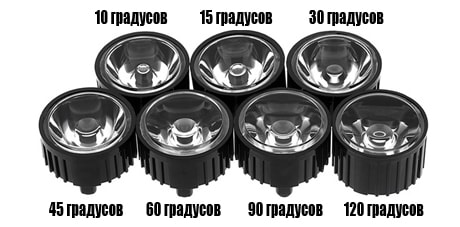
They can be used, but the problem is that you need a different lens for each LED. If the increase in size is not frightening, then this is the most convenient option.
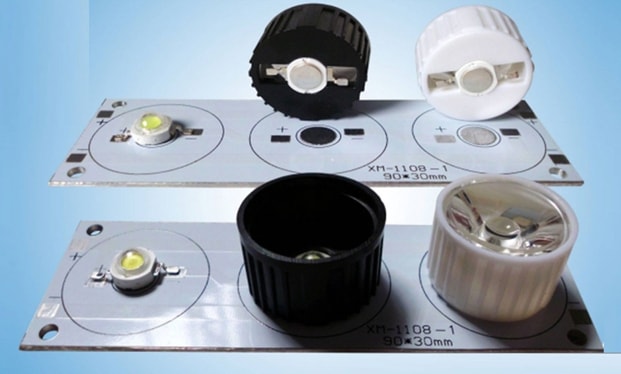
The required number of LEDs must be mounted on heat sinks. They can also be picked up ready-made. They serve as mounting plates and heat sinks, but their area is small for efficient heat dissipation, so the plates must be strengthened by additional radiators. Mounting plates can also be made by yourself. Two conditions must be met:
- Isolation of pins from the substrate;
- good heat exchange between the LEDs and the heat sink - you can use thermal paste for this.
Next you need to connect LEDs in in series The lights should be connected to the on-board power system of the car and installed in the selected location.
To power a group of LEDs from the on-board power system of the car, it is necessary to install at least the simplest voltage regulator. It can be made on an integral voltage regulator LM7812. The problem is that for normal operation such a regulator needs at least 13.5 volts at the input. If the on-board voltage drops below (when powered from the battery), then the output will be less than 12 volts, which will lead to a drop in luminous flux. If you do not put a stabilizer, the LED will have a higher voltage, which will adversely affect the life of the elements. Also needed is a ballast resistor. Better yet, use a premade driver, designed for the appropriate input and output voltage and current corresponding to the load power.
Important! Do not install more than three LEDs in a daisy chain - there is not enough voltage to open the LED transitions.
We recommend reading: How to choose running lights not to get fined, installation according to GOST
When the work is complete, you can test the work of the resulting system running lights and go to the traffic police for the legalization of light-signaling equipment. Without it, you can not operate the homemade lighting equipment.
For more details about 3 more ways of production see the video.
